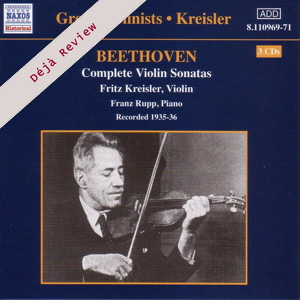
Déjà Review: this review was first published in April 2003 and the recording is still available.
Ludwig van Beethoven (1770-1827)
Violin Sonatas Nos 1-10 (1798-1810)
Fritz Kreisler (violin), Franz Rupp (piano)
rec. April 1935 – June 1936, EMI Studio 3, Abbey Road, London, UK. Mono ADD
Naxos Historical 8.110969-71 [3 CDs: 208]
Naxos’s Historical series continues at a dizzying rate. They are certainly to be applauded for re-issuing famous existing recordings at super budget price, as well as unearthing other treasures from the archives. The present release is particularly valuable, as it is, as far as I know, the first complete cycle of the Beethoven Violin Sonatas to be recorded. The fact that it features one of the most influential musicians of the early 20th Century makes it especially welcome.
The idea of presenting complete cycles of the sonatas in public did not start with Kreisler, but when the brains behind this recording, the legendary Fred Gaisberg, wanted to commit the whole cycle to disc, his choice of fiddler was clear – it had to be Kreisler. The choice of pianist was more difficult, as Tully Potter’s entertainingly informative note tells us. Rachmaninov was considered (if only!), but would have been too expensive. Kreisler had no regular partners of his own stature, though he did give recitals with the great Harold Bauer, which would have also been interesting. The team ended up with Franz Rupp, pretty much unknown in recorded music history, save for this recording. As it turns out, Rupp’s playing is efficient and professional rather than truly inspired. He was quite young at the time, and as surprised as anyone to get so important a job, and whilst his playing does not seriously undermine the set, it is mouth-watering to imagine what sparks might have flown if Kreisler had been partnered with a truly great pianist, as Casals was in his set of the Cello Sonatas with Horszowski.
The chief enjoyment throughout these discs is the playing of Kreisler himself. His tone is sweet and totally unforced, with elegant phrasing, lyrically shaped lines and a lack of the sort of indulgent portamento that I thought would be here in spades. The playing actually sounds surprisingly modern, and there is a no-nonsense approach to these works that is refreshingly direct. The early sonatas find Kreisler and Rupp on their best form. The beautiful theme and variations of the D major, Op.10 has an eloquence and purity of line that is most fetching. There is a general refusal to linger in slow movements, which certainly goes down well with me, and only in some of the bigger sonatas do I miss an extra dimension. The famous canonic scherzo of the ‘Spring’ sonata is slightly lumpy, not helped by a stodgy basic tempo and a feeling that the two players slightly disagree over things. The glorious opening flourish of the ‘Kreutzer’ is well handled by Kreisler, only to be followed by a rather puny entry from the pianist. My favourite piece, the final Sonata Op. 96, has its moments, not least the bucolic finale, where the great violinist is clearly enjoying himself. Even here, I felt a partner with the same outsize personality might have created results that were more memorable than they actually are. Still, the lilting, affectionately Viennese style of violin playing is hugely enjoyable, and it is a real glimpse of an artist at his peak.
The transfers are wholly successful, with Ward Marston again performing near miracles of engineering. The violin sound in particular has enormous presence and clarity, though of course this could be the player himself! Whatever the case, there is a great deal to enjoy here, and no serious collector of historic violin performances will want to be without this set. Its appearance on three very well filled, super-budget discs makes it a gift which should be snapped up without delay.
Tony Haywood
Help us financially by purchasing from


















